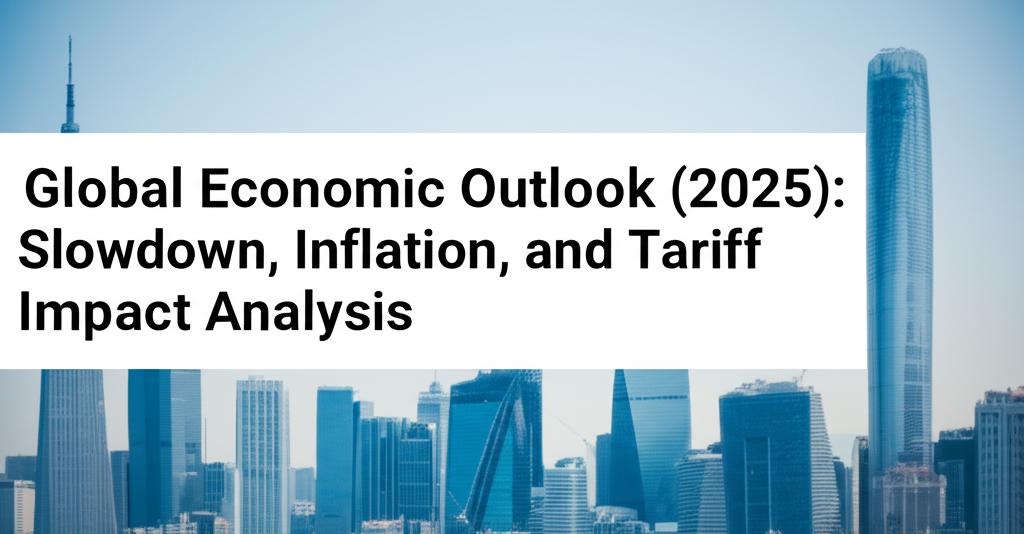The global economy in 2025 is navigating a period of considerable uncertainty, characterized by a projected slowdown in growth, persistent, albeit moderating, inflationary pressures, and the significant impact of evolving trade policies, particularly tariffs.
Economic Slowdown:Multiple forecasts indicate a deceleration in global economic growth for 2025. The OECD projects global growth to slow to 3.1% in 2025. The IMF, in its April 2025 World Economic Outlook, also revised its global growth forecasts downward, emphasizing that policy shifts and new uncertainties are contributing to this trend. For instance, US GDP growth is projected to slow to around 2.2% in 2025 by some analysts, down from 2.8% in 2024, with a further deceleration anticipated in 2026. The Euro area is expected to see modest growth, potentially around 1.0% to 1.3% in 2025, surpassing 1% for the first time in three years according to some estimates. China's growth is also expected to moderate to around 4.5% in 2025 due to structural challenges despite policy support. However, India is seen as a bright spot, with growth anticipated around 6.4%, driven by public investment and strong domestic demand. Overall, the global economy is expected to grow at a slower pace than the pre-pandemic average. Headwinds identified include geopolitical fissures, divisive domestic politics, technological disruption, demographic trends, rising inequality, natural resource scarcities, high government debt, and deglobalization.
Inflation Dynamics:Global inflation is generally expected to continue its downward trend in 2025, but at a slower pace than previously anticipated and with regional variations. The OECD projects annual headline inflation in G20 economies at 3.8% in 2025. The IMF forecasts global headline inflation to decline to 4.5% in 2025. Some analysts see global inflation easing from 4.5% in 2024 to 3.5% in 2025, which is still above pre-pandemic levels. Services price inflation remains elevated in some regions due to tight labor markets, and goods price inflation has shown signs of picking up in certain countries. Inflation expectations for 2025 have seen slight upward revisions in some analyses, with the expected global average inflation rate hovering around 4.0%. Advanced economies are generally expected to see inflation return to target sooner than emerging market and developing economies. However, risks to the inflation outlook are tilted to the upside, stemming from increased protectionism, geopolitical tensions, and persistent wage and services costs.
Tariff Impact Analysis:The implementation and potential escalation of tariffs, particularly by the US, are a major factor shaping the 2025 economic outlook. Recent tariff announcements have been described as leading to effective tariff rates not seen in a century, creating a highly unpredictable environment. These trade restrictions are anticipated to contribute to higher production and consumption costs. Analysts warn that escalating trade tensions and heightened trade policy uncertainty could further hinder both short-term and long-term growth prospects. Sweeping US tariff increases in 2025 are projected to cause sharp contractions in trade, significant welfare losses (especially for the US), and major disruptions to global supply chains. Direct trade between the US and China is expected to be severely affected, potentially collapsing by as much as 90% under certain scenarios. While some rerouting of trade flows may occur, the overall impact is likely to be a less efficient and more opaque global trade system. Tariffs are also expected to contribute to inflationary pressures, as importers pass on increased costs to consumers. The uncertainty surrounding the final tariff framework is also weighing on business and consumer sentiment, potentially delaying investment and spending decisions. Some analyses suggest that tariffs, alongside other policy shifts, could push the global economy towards "stagflation" – a combination of economic stagnation and elevated inflation.
In summary, 2025 is shaping up to be a year of modest global economic momentum with significant regional divergences. While inflation is expected to ease, the pace may be slower than hoped, and new trade barriers pose a considerable risk to both growth and price stability. Navigating this complex environment will require careful policy calibration and international cooperation to foster a stable and predictable trade environment.

